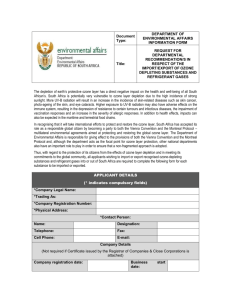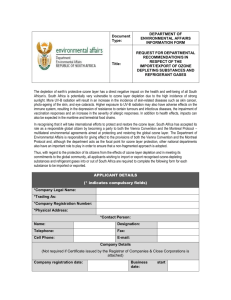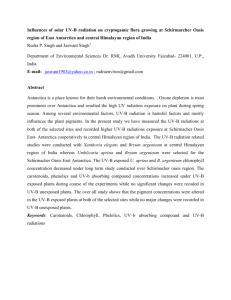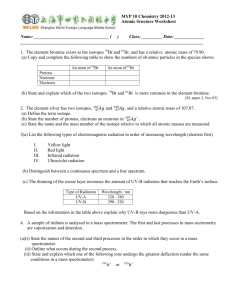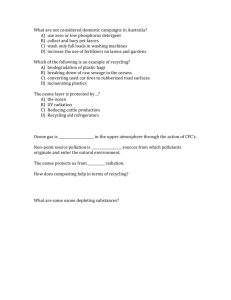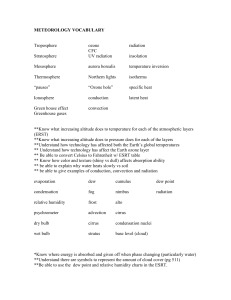organisms elsewhere
advertisement
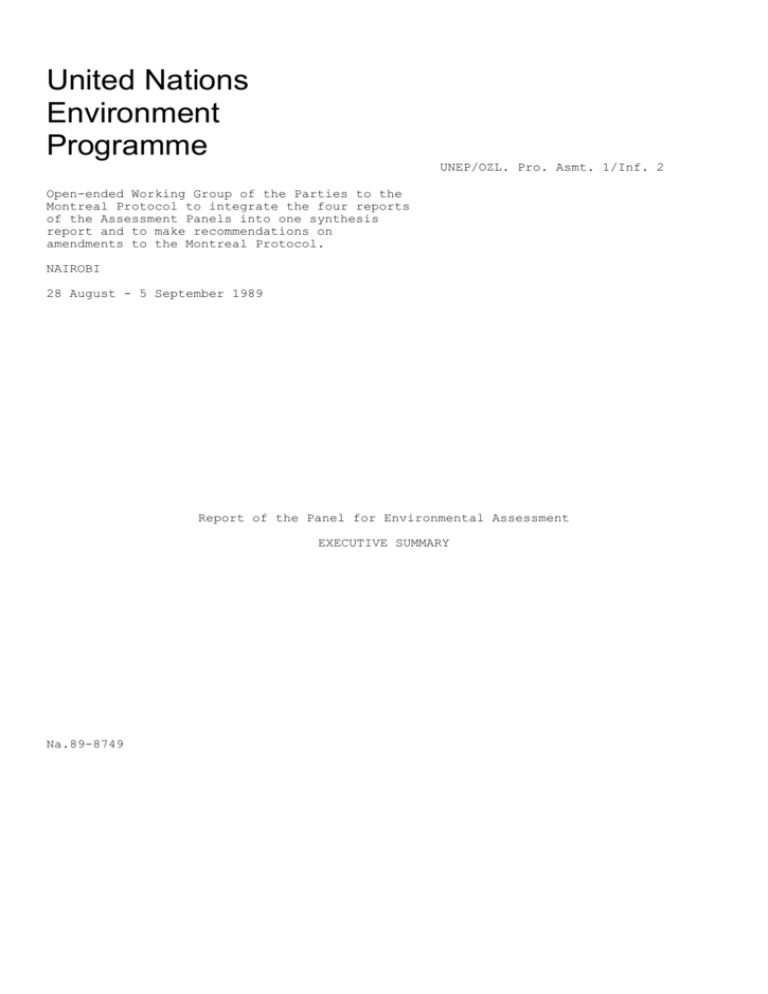
United Nations Environment Programme UNEP/OZL. Pro. Asmt. 1/Inf. 2 Open-ended Working Group of the Parties to the Montreal Protocol to integrate the four reports of the Assessment Panels into one synthesis report and to make recommendations on amendments to the Montreal Protocol. NAIROBI 28 August - 5 September 1989 Report of the Panel for Environmental Assessment EXECUTIVE SUMMARY Na.89-8749 Environmental Effects of Ozone Depletion EXECUTIVE SUMARY In accordance with the provisions of the Montreal Protocol on Substances that Deplete the Ozone Layer, the United Nations Environment Programme (LINEP) developed a set of reports, providing an assessment of current knowledge of scientific, environmental, technical, and economic matters relevant to the implementation of the Protocol. The present report on Environmental Effects of Ozone Depletion deals mainly with the direct effects of increased ultraviolet-B (0-11BI) radiation on man and the environment. The report was written in 1989, the year that the Montreal Protocol came into effect. The Parties to the Protocol have agreed to specified limits on the production of certain gases that endanger the ozone layer. It was widely realized that the threat to the ozone shield was no longer the Occurrence of a "hole" in the ozone layer has been observed in the Antarctic region. r1i the time that the Protocol was signed, there were scientific data indicating that the limitations for the substances agreed upon were not sufficient for a recovery of the ozone layer. Parties advocated stricter limits and the inclusion of more gases. This report is intended to assist decision makers - particularly those involved in the policy process - by reviewing and integrating scientific information on potential effects associated with various levels of stratospheric ozone decrease. Clearly, the report would be the most useful if it could provide clear-cut quantitative predictions of the effects to be expected from the different policy options under consideration. The actual situation is rather far from that goal. The scientists involved in effects research can at best derive tentative conclusions with regard to the impact of ozone depletion. The principal limitation is insufficient information. Investigations have shown that ultraviolet radiation has a multitude of effects on man, anims1s, plants and materials; most of these effects are damaging. The knowledge required for quantitative predictions, however, is available for only a few of these areas. For each area there is a need to know 1) the dependence of the specific effect on the wavelength of le radiation, 2) the relationship between dose and effect, and 3) modifying factors, such as adaptation and interactions between organisms. The change of both the quantity and quality of UV-B radiation is different for the various CFC control scenarios relevant. to the Montreal Protocol and varies with time in every scenario. Moreover, the atmospheric models from which the decreases of ozone are computed are still being improved. Every refinement may cause an adjustment of the U`V-B radiation expected. In addition, the scenarios themselves may have to be changed to adapt to new policy decisions, or to changes in projections for global production of CFCs and halons. Investigators studying effects of increased levels of UV-B radiation have to deal with a range of expected UV-B increases, which is subject to change. Their experiments usually take several years and cannot readily be adapted to frequently changing scenarios. Most investigators have chosen to examine the effect that is expected from a particular decrease of t6tal column ozone, or a limited set of decreases. Studies have been conducted on effects of increased UV-B irradiance on human health, plants, aquatic organisms, air quality, and man-made materials. Significant changes are likely in each of these areas. With regard to a few effects areas, investigators feel confident enough with the results to provide quantitative predictions. In other areas, the findings give reason for concern, but the effects cannot yet be quantified or confirmed. This difference in certainty and specification of the conclusions reflects the complexity of the issues and the state of the relevant scientific knowledge, rather than the potential importance of the effects. For example, a prediction of the influence of increased UV-B on world food supply would be very difficult. Broad systems such as agriculture and fisheries, are so complex that many influences would be to occur and to interact with each other, making the research problem difficult to address. Yet, an overall negative influence of increase UV-B on food supply would be very important. The information available for each of the areas of concern is summarized here. The individual chapters of the report provide a more detailed discussion of the state of the science and an assessment of results. Solar Interactions With depletion of the ozone layer, the atmosphere becomes more transparent to solar ultraviolet radiation. A certain type of ultraviolet radiation is affected primarily in a wavelength range of 280 to 315 nanometers, which is called LTV-B radiation. Bog the intensity and quality (wavelength composition) of the LTV-B radiation are affected by changes in the ozone layer. The intensity increases and the wavelength composition is shifted to shorter wavelengths. Most effects of ultraviolet radiation depends strongly on the wavelength of the radiation. This is displayed in "action spectra,- = are different for the various effects. Changes in the solar UV radiation climate of the earth pose a threat. What this portends for man and other organisms depends on the amount of ozone reduction, the time of year, the location on earth especially with respect to latitude, and the nature of the biological and other effects of the increased UV. - The ozone hole over the Antarctic region in early spring has been firmly established and the resulting increase in UV-B radiation when confirmed by measurements. - At temperate latitudes (30-600), the process of ozone layer depletion has already started. - Based solely on ozone layer thickness, the absolute increments, of effective UV-B at tropical latitudes are calculated to become at least as great as the increased UV-B associated with the Antarctic ozone hole. Human Health - Exposure to increased UV-B radiation can cause suppression of the system, which might lead to an increase in the occurrence or severity of infectious diseases and a possible decrease in the effectiveness of vaccination programs. - Enhanced levels of UV-B radiation can lead to increased damage to the eyes, especially cataracts. A cataract is a clouding of the eye lens - a condition that causes impaired vision and blindness in many people. Another concern is increased of kerato-conjunctivitis, or "snowblindness," which is a painful but usually transient condition of the years. - Non-melanoma skin cancer is predicted to increase with any long-term increase of the UV-B irradiance, without a threshold value. The increase will not be directly proportional: every 1% decrease of total column ozone will result in a 3% rise of the incidence of non-melanoma skin cancer. There also is concern for an increase of the more dangerous cutaneous melanoma. Terrestrial Plants - Of the plant species investigated, about half were found to be sensitive to enhanced levels of UV-B radiation. Within species, varieties have different UV sensitivities. - Sensitive plants; are typically shorter and have smaller leaves when grown under enhanced W-B. In some cases these plants also show changes in their chemical composition, which can affect & quality of food and the availability of mineral nutrients. - In some soybean varieties, increased UV-B reduced food yield and quality. - Increased UV-B may reduce the biodiversity of forests and other terrestrial ecosystems. Aquatic Ecosystems - Increased UV-B irradiance has been shown to have a negative influence on aquatic organisms, especially small ones such as phytoplankton, zooplankton, larval crabs and shrimp, and juvenile fish. - Because many of these small organisms are at the base of the marine food web, increased UV-B exposure may have a negative influence on the productivity of fisheries. Increased exposure to UV-B radiation could lead to decreased nitrogen assimilation by prokaryotic microorganisms and, thereby, to a drastic nitrogen deficiency for higher plant systems, such as rice paddies. - Phytoplankton in the oceans are a major sink for carbon dioxide in the atmosphere. A decrease in phytoplankton would leave the atmosphere with higher carbon dioxide concentrations, and so contribute to the green house effect. Tropospheric Air Quality - The chemical reactivity in all regions of the lower atmosphere (troposphere) would increase if stratospheric ozone depletion leads to increased surface UV-B levels. - Increase in potentially harmful oxidized compounds, including urban and rural ozone, hydrogen peroxide, acids, and possibly aerosols, could occur in most rural and urban regions. This would result in a decline in the percentage of remote (pollution free) area and an increase in areas with urban-like pollution. - Degradation of air quality will exacerbate problems related to human health and welfare, will probably increase stress in the biosphere, and could m are current air quality goals more difficult to attain. Materials Damage - Exposure to UV radiation is the primary cause of degradation of materials, particularly plastics used outdoors. Increased UV radiation levels will increase the rate at which plastic products degrade, reducing the outdoor lifetime of the products. - The increased damage will be more severe at locations near the equator, where the degradation may be enhanced by high ambient temperatures and sunshine levels. Developing countries in these areas are particularly susceptible because of the growing use of plastics in building. - Virtually no relevant data on other important classes of materials are available, limiting the ability to develop comprehensive economic projects. Such materials include rubber products, paints/coatings, wood, paper, and textiles, all of which will be affected by increased levels of UV-B radiation. Summary of MW Concerns Additional research is needed to gain a more complete understanding of these primary effects especially in tropical and subtropical areas. Even with the present state of knowledge, it is clear that some of these effects cause a significant threat, including the following: - Decreased food ]production from UV-B impacts on agriculture or the oceans productivity would significantly affect people in areas where shortages occur even now, which are mainly developing countries. - Damage to the eyes and possible increases in incidence or severity of infectious diseases would be serious, primarily for people in tropical and subtropical areas, where UV-B irradiance is already much higher than elsewhere. - Skin cancer would affect mainly people with little protective pigment in their Skin. - Polar and circumpolar areas receive comparatively little UV-B radiation, but the increases already apparent are more dramatic than elsewhere. Organisms in these areas may be least adapted to deal with increases in UV-B radiation. - Damage to phytoplankton by increased UV-B radiation would contribute to global climate change. Given this information, it is clear that the possible consequences of ozone depletion are truly global in nature, requiring global action to prevent or mitigate the damage. The report on Environmental Effects of Ozone Depletion was prepared by an international group of scientists. The chairman of the group was Prof Dr. J.C. van der Leun (The Netherlands); the co-chairman was Prof Dr. M. Tevini (Federal Republic of Germany). United Nations Distr. Environment Programme GENERAL. UNEP/OZL.Pro.ASMt.l/nf.2 Corr.1 11 August 1989 ORIGINAL: ENGLISH Open-ended Working Group of the Parties to the Montreal Protocol to integrate the four reports of the Assessment Panels into one synthesis report and to make recommendations on amendments to the Montreal Protocol. NAIROBI 28 August - 5 September 1989 CORRIGENDUM TO the Executive Summary of the Report of the Panel for Environmental Assessment Please note the following corrections to the Executive Summary of the Report of the Panel for Environmental Assessment (Document UNEP/OZL. Pro. Asmt. l/Inf. 2). The document delivered by mail without this cover page is the correct version. Page ii, second and third points under the heading Human Health should read; • Enhanced levels of UV-B radiation can lead to increased damage to the eyes, especially cataracts. A cataract is a clouding of the eye lens -- a condition that causes impaired vision and blindness in many people. Cataracts were estimated to increase by 0.6% per 1% ozone depletion. This increase would amount to 100,000 addtional blind persons worldwide. Another concern is increase of kerato-conjunctivitis, or snowblindness, which is a painful but usually transient condition of the eyes. • Non-melanoma skin cancer will increase irradiance, without a threshold value. one; every 1% decrease of total column incidence of non-melanoma skin cancer. more dangerous cutaneous melanoma. with any long-term increase of the UV-B The percentage increase will not be one to ozone will result in a 3% rise of the There is also concern for an increase of the Page iii, the second point from the top of the page should read; ▪ in some soybean varieties, increased UV-B reduced food yield up to 25% for an exposure simulating a 25% ozone depletion. Page iv, the last point under the heading Summary of Major Concerns should read. ▪ Because phytoplankton fix carbon dioxide in photosynthesis, damage to phytoplankton by increased UV-B radiation would indirectly contribute to predicted global warming induced by greenhouse gases. United Nations Environment Programme UNEP/OZL. Pro. Asmt. 1/Inf.1 open-ended Working Group of the Parties to the Montreal Protocol to integrate the four reports of the Assessment Panels into one synthesis report and to make recommendations on amendments to the Montreal Protocol. NAIROBI 28 August - 5 September 1989 Report of the Panel for Scientific Assessment EXECUTIVE SUMMARY 14 July 1989 Na.89=8748
